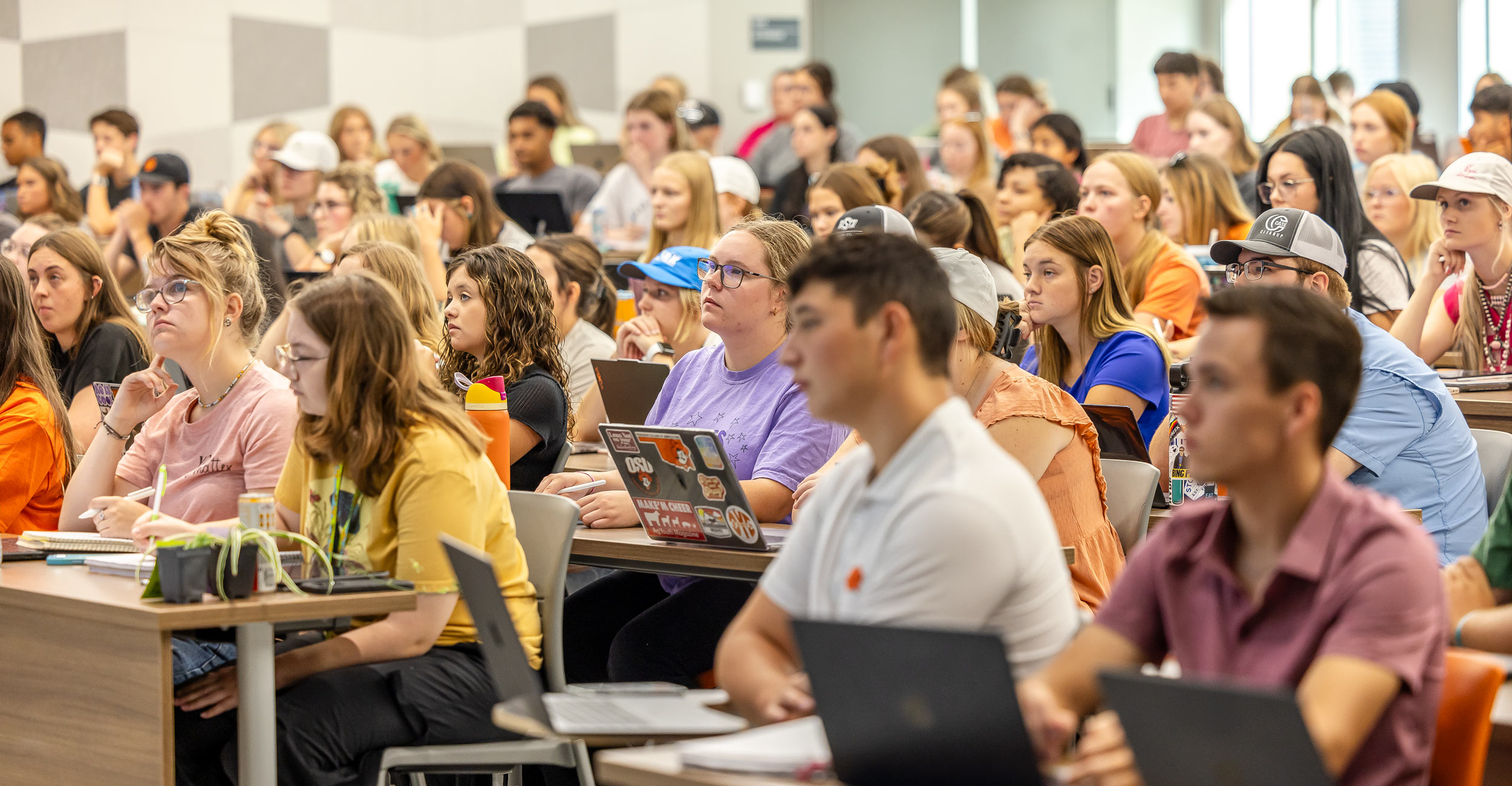
Early warnings, lasting impact: How OSU’s academic alerts support student success
Thursday, February 13, 2025
Media Contact: Sydney Trainor | Communications and Media Relations Specialist | 405-744-9782 | sydney.trainor@okstate.edu
From varying academic loads to individual experiences — every student’s journey is unique.
For freshmen, starting college can be exciting and intimidating at the same time. They are eager to see what the next chapter of their lives has in store but unsure of what challenges lie ahead.
Often, it’s those challenges causing students to struggle in their classes, earning them a less-than-desirable grade or causing them to withdraw from a course.
However, a recent study published by Oklahoma State University shows academic alerts — an early intervention system — are associated with lower course withdraw rates and higher average course grades.
So, what is an academic alert system?

It’s a collaborative system used by instructors and advisors to identify students at risk of underperforming or withdrawing from a course.
In this system, instructors submit an alert directly tied to the student and the course, indicating issues with course attendance or performance.
Once alerts are received by the advisor and student, the advisors work diligently to address them immediately with each student via text, phone call, email, or in person.
“We're trying to get ahead of this as much as we can and see what's going on with our students, so we get them on the right page before midterms, and they can salvage for what they lost,” said Dan Link, assistant director of advising.
In some cases, if students receive an alert in one class, they are most likely receiving alerts for other classes. The alerts are just one way OSU shows students they care about their success and want to provide the highest quality services possible.
Link and his team of advisors understand that academic alerts can stem from academic and personal circumstances specific to the individual student. These alerts provide an opportunity for an open dialogue to offer services and resources.
“An academic alert opens the door to have that conversation with the faculty, so the student can then feel supported on both sides: the faculty and advisor,” Link said. “It can be intimidating to talk to your faculty, and that way, we can have that open communication to help the student and come up with interventions to help that and support that student. So, it just opens the door to find a plan for the student to be successful.”
But the question still remains, how effective are the alerts?

That’s what the OSU Institutional Research and Analytics team set out to investigate.
Dr. Kwideok Han, an OSU data scientist, said the team evaluated if the use of the academic alert system was linked to better grades or lower withdrawal rates in a course.
OSU Chief Data Officer Larry Burns said OSU was interested in exploring whether an instructor’s use of academic alerts influences the entire class, regardless of individual student participation. The goal was to demonstrate that the overall use of academic alerts has a broader impact on students as a whole.
IRA focused on a sample of students enrolled in freshman and sophomore-level undergraduate courses where a group of instructors employed academic alerts and another group did not.
The results indicate that students enrolled in courses with instructors using academic alerts are approximately 30% less likely to withdraw from the course and 4% more likely to receive a grade higher than a C as compared to students in courses with instructors not using alerts.
As part of the academic alert system, reporting six-week grades and excessive absence alerts are required for 1000 and 2000-level courses. However, based on IRA’s findings, Dr. Chris Francisco, senior vice provost for academic affairs, said this research confirms the message OSU has been sending to instructors — the earlier and more often students and advisors are alerted to more opportunities to intervene and provide resources to make a change.
Francisco wants students to know each alert sent is someone identifying a problem and extending a hand to help a student.
“Sometimes that academic alert is just enough to have an advisor or have somebody else be able to reach out to the student and kind of help them understand that there are these resources that they should go ahead and take advantage of even if they didn't think maybe they needed them before,” Francisco said.
From free tutoring to mental health, OSU has various resources for students to take advantage of.
OSU’s use of academic alerts and the effectiveness of those academic alerts are symbolic of everything the university is trying to do to create a community, Francisco said.
“We're going to work together as a team across campus to address any issues, whether they're academic issues or outside the academic sphere, and we have people who are experts in all of these areas who can provide whatever services the students need,” Francisco said.
Bradford Cary is a management science and information systems instructor in the Spears School of Business who has anywhere from 300 to 900 students in his business data technologies course each semester.
With so many students, Cary can't meet one-on-one with everyone. Academic alerts help him reach out to students early so that they can ask for help. He contacts students in the first few weeks of the semester rather than waiting on six-week grades to let students know where they stand. Often, this results in students reaching out for ways to improve earlier in the semester rather than waiting until the drop/withdraw date.
When a student comes to Cary and asks how to improve their grade, he lays out a path to help them achieve their goal. If they follow the path, they usually get their desired outcome.
“I do see in students that care; sometimes that nudge is all they need,” Cary said.
That nudge to help students keeps IRA researching ways to improve academic alerts.
“That's our motivation, to help, which is what we do all the time, by just figuring out how we can make things more efficient, run things better, and make things more focused on the strategy,” Burns said.
With the goal of increasing advising capacity by 20%, IRA is already looking ahead. As they continue their research, they plan to explore the timing of alerts, the impact of specific alerts and the factors influencing faculty decisions to use or not use them.
“We can inform the advising practices of the university, not only the teaching but the advising part of it. All of this is playing into the strategy,” Burns said. “We want to help figure out a way to make advisors reduce the workload and make their use of their time more strategic.”
